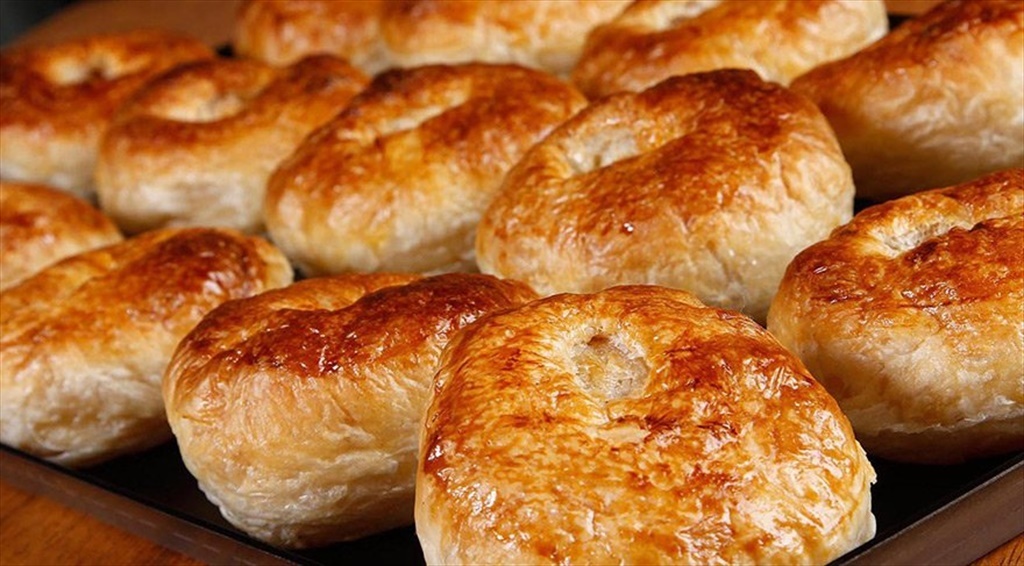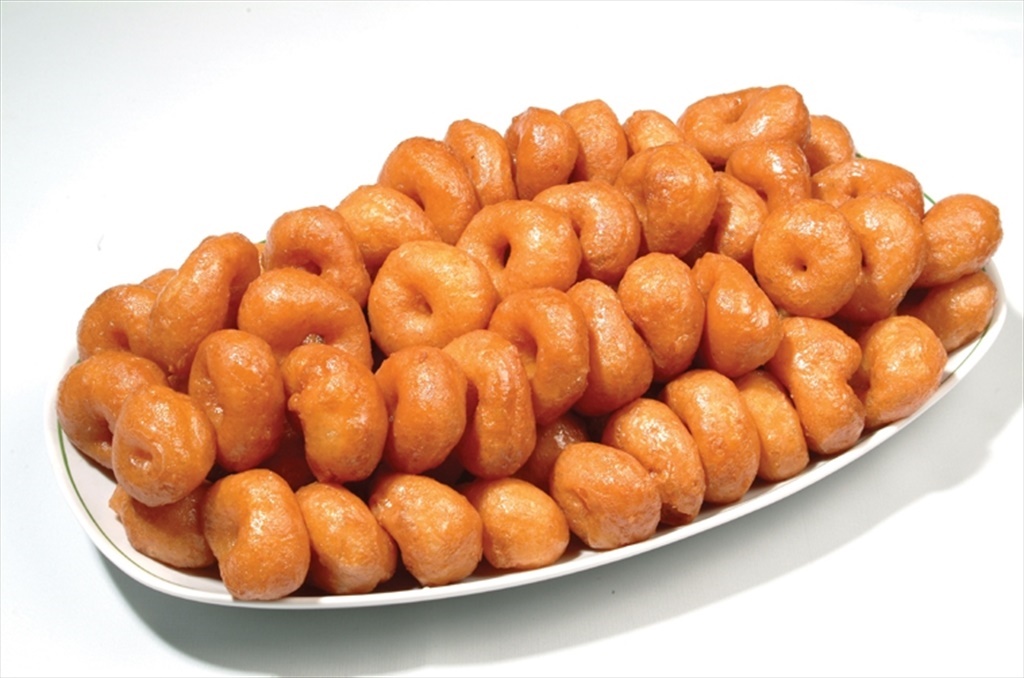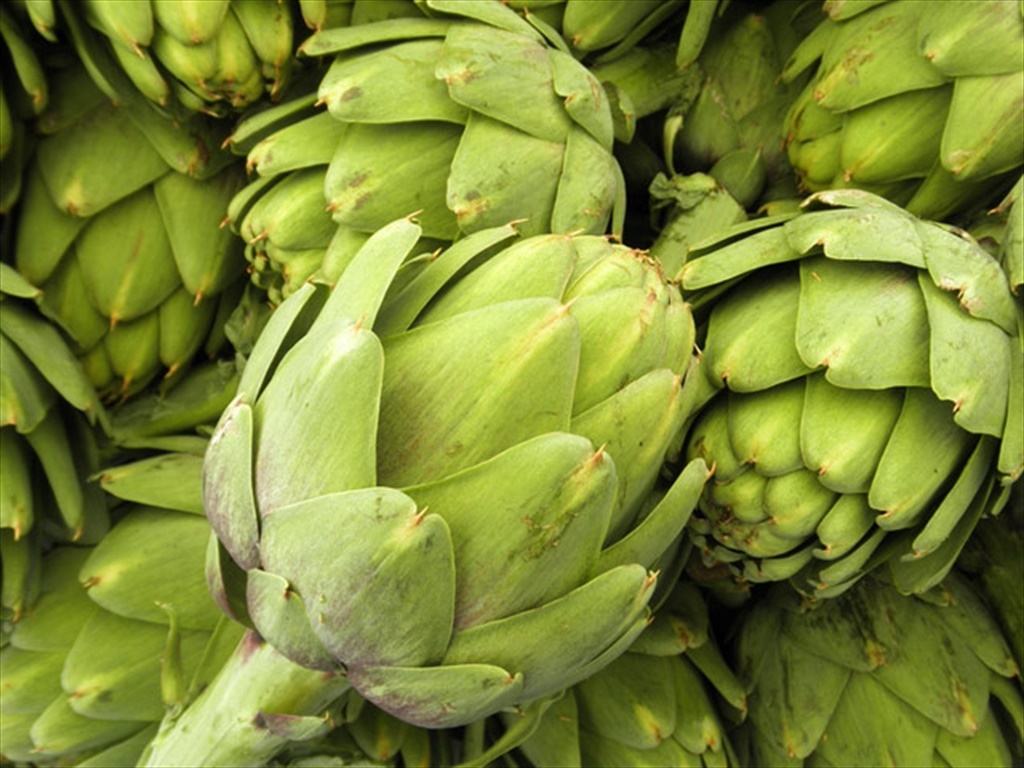1. İzmir Boyoz
One of the first flavors that come to mind when İzmir is mentioned, boyoz is an unleavened pastry unique to İzmir. “İzmir Boyoz” is a registered geographical indication product. Added to the İzmir cuisine of Sephardic culture, boyoz is an essential item on the breakfast tables. Boyoz is at the top of the list of flavors you must try.
2. İzmir Gevrek
One of the most commonly consumed pastries in Turkey “Simit” is known as “Gevrek” in İzmir. It’s made by a chickpea yeasted dough that is rolled into a circle shape, deep fried in grape molasses for a short time then coated with sesame seeds and baked in the oven. Receiving a geographical indication, İzmir Gevrek is one of the most tasted flavors in İzmir.
3. İzmir Tulum Cheese
İzmir’s famous Tulum Cheese is registered as a geographical indication. It has two varieties, dry in goatskin and brined in tin. It’s a requirement for breakfasts and kumru.
4. İzmir Kumru
İzmir Kumru, which has been produced in İzmir for about 150 years, is consumed by the people of İzmir almost every day. It is usually made using chickpea yeast, and it is called a dove because it resembles the bird's body in shape with its wider middle part and tapering towards the ends. İzmir Kumru is a registered geographical indication and it's served cold by adding İzmir Tulum Cheese, tomatoes, and peppers.
5. İzmir Şambali
İzmir’s geographical indication dessert Şambali, is a dessert with syrup that resembles revani (a semolina cake with syrup) but firmer. Served by slices Şambali can be enjoyed plain or paired with cream and cinnamon. It’s possible to find İzmir Şambali in Kemeraltı Bazaar.
6. İzmir Lokma
As a geographical indication of İzmir, Lokma is a dessert that is prepared with a donut-shaped deep-fried dough that is sweetened and served with syrup. Lokma is consumed as a sweet in İzmir City but in some regions preferred without syrup and with cheese.
7. Bergama Kozak Pine Nut
Bergama Kozak plateau provides a significant share worldwide and 80% of the national production of pine nuts. With its 500-meter elevation from the sea level and 70-80% humidity, the Bergama Kozak plateau provides the most suitable conditions for pine trees. Bergama Kozak Pine Nut, which is the geographical indication of İzmir, is the main source of income for the people of the region and is delivered to different corners of the country and the world.
8. Seferihisar Mandarin
The story of Seferihisar's geographical indication of Mandarin began with the planting of 600 satsumas in 1953. Over time, mandarins have become commercially prominent in terms of cultivation and export. This story is crowned by the fact that every year at the beginning of the harvest season a mandarin festival is held.
9. Gümüldür Mandarin
Gümüldür Mandarin, which is the geographical indication of Menderes, grows at the shores of Gümüldür. World-famous satsuma breed mandarins are juicy, seedless and thin-skinned.
10. Urla Sakız Artichoke
Urla Sakız Artichoke, a registered geographical indication, is one of the most consumed vegetables of İzmir cuisine, which is famous for its olive oil dishes. A variety of recipes includes Urla Sakız Artichoke and it’s a must-try taste of Izmir cuisine.
11. Çeşme Melon
As a geographical indication of Çeşme, melon grows in the fertile soil of the Çeşme peninsula almost without the need for irrigation. Harvested in August, Çeşme Melon’s most distinctive property is its specific aroma and durability.
12. Ödemiş Meatball
Known as “fatty kebab” among the local community, registered geographical indication Ödemiş Meatball's secret is to hide its convergence with butter for a few minutes after being grilled. İt is one of the tastes that shouldn’t be skipped out on.
13. Bozdağ Chestnut Candy
As a geographical indication of Ödemiş, Bozdağ Chestnut Candy is produced from Bozdağ chestnuts. Its prominent features are; its large size, bright colors, unified form and pleasant taste. These features separate Bozdağ Chestnut Candy from other chestnut desserts from different regions.
14. Ödemiş Çekişte Olive Oil
The cold-pressed oil of “Çekişte Olive” grown in Ödemiş has been registered as a geographical indication. The Çekişte Olives that grow on the foothills of the Bozdağ are distinguished from other olive brands with their large size and flavor. Its early harvest happens at the beginning of December and the second harvest known as the “Çakır” harvest takes place during the new year.
15. Ödemiş Potatoes
With its warm and moderate climate, Ödemiş has ideal conditions for potato farming and it is an important potato-growing center in Turkey. Ödemiş Potato is a registered geographical indication product.
16. Tire Şiş Meatball
Unique to the region and Geographical Indication Tire Şiş Meatballs are prepared without any spices other than salt and threaded onto the skewers. The grilled meatballs are served with a generous amount of tomato sauce poured bread.
17. Bornova Kınalı Okra
A geographical indication product of Bornova, Kınalı Okra is one of the essential vegetables of the Aegean cuisine which is famous for its olive oil dishes.
18. Bornova Misket Grapes
Bornova Misket Grapes, which is the geographical indication of Bornova’s, is especially preferred for winemaking. Due to its midsized and abundant grapes, it has a profound flavor.
19. Kavacık Grapes
Kavacık Grape grown in Kavacık, the beautiful village of Karabağlar, is a product with geographical indication. This breed of grapes has an excellent harmony with Kavacık’s ecology. The grapes that are raised here are so admired that the name of the breed is often called “Kavacık Grapes” instead of its original name “Alphonse Lavallée”
20. Kemalpaşa Cherry
Due to its flavor, Kemalpaşa Cherry holds a privileged position in the world of Anatolian fruits. Kemalpaşa Cherry is registered as a geographical indication.
21. Çavuşdağ Haricot Beans
Haricot Beans of Çavuşdağ is a registered geographical indication to Kiraz. It is grown without using fertilizers or pesticides.
22. Aegean Fig
The “Sarılop” breed Figs, grown in Torbalı, Bayındır, Kiraz, Ödemiş, Tire, Beydağ and Selçuk districts are geographically indicated as “Aegean Fig”.
23. Aegean Sultani Grapes
Known as “İzmir Grapes” in Turkey, Seedless Sultani Grapes received a geographical indication as “Aegean Sultani Grapes” and produced in Kemalpaşa, Menemen, Menderes, Bayındır and Torbalı districts in İzmir.
24. Northern Aegean Olive Oil
The extra virgin olive oil produced in the region that includes Dikili, Bergama(Zeytindağ) and Aliağa Şakran districts received a geographical indication as “Northern Aegean Olive Oil”.
25. Southern Aegean Olive Oil
The olive oil obtained from the olives grown in the region covering the districts of İzmir Foça, Menemen, Kemalpaşa, Ödemiş, Tire, Torbalı, Bayındır and Selçuk has been registered geographical indication as ‘’Southern Aegean Olive Oil”.
26. Kınık Sun-Dried Tomato
Kınık Sun-Dried Tomato is a tomato dry obtained by cutting tomatoes in half in the middle and slicing them according to the request of the operators immediately after harvesting and drying them under the sun.
27. Torbalı Sun-Dried Tomato
Torbalı Dried Tomato; It is the dried tomato obtained by cutting the tomatoes, which are planted in April and harvested in July, in half immediately after harvest, dried under the sun, washed and dried again.
28. Arslanlar Pepper
Arslanlar Pepper is a Capsicum Annuum Jalapeno pepper grown in Arslanlar Village of Torbalu district of Izmir province. Arslanlar Pepper dates back to approximately 120 years ago and is also called "yörük pepper" in the geographical border. It is cultivated by planting the seeds taken from the first harvest of the previous year.
29. Bergama Meatball
Bergama Meatballs are meatballs prepared in oval or square shapes using beef, semolina, yellow flour, cumin and salt and cooked in an oak wood fire and on a slotted grill. The history of Bergama Meatballs dates back to the past. It has an important place in the cuisine of the Bergama district. For these reasons, it has a reputation linked with the geographical border.
30. Beydağ Simit Dürümü
Beydağ Simit Wrap is a pastry product produced in the Beydağ district by wrapping the dough, which is prepared with special-purpose wheat flour, yeast, salt and flour and shaped into a ring, in lavash prepared with special-purpose wheat flour, water and salt and cooked on a sheet with sunflower or corn oil after baking in the oven. It is called "simit dürüm" because the ring-shaped dough baked in the oven resembles a bagel and is wrapped like a wrap. It is served hot.
31. Gökçealan Osmancık Grape
Gökçealan Osmancık Grape; It is an Osmancık variety grape grown in Gökçealan Village of Selçuk district of İzmir province. If there is a risk of phylloxera pest in the geographical border, the root system is obtained from American vine rootstocks and the stem system is obtained from Osmancık variety.
32. Ödemiş Chickpea Bread
Ödemiş Chickpea Yeast Bread is a bread produced in the Ödemiş district of İzmir province using chickpea yeast, wheat flour, salt, olive oil and water. Its weight is approximately 1.5 kg. The height of the puffed bread is 10 cm. The size of Ödemiş Chickpea Yeast Bread is usually 20x30 cm rectangular or 25x25 cm square.
33. Bademli Koruk Sherbet
Bademli Koruk Sherbet is a fruity syrup produced in the Bademli Neighborhood of the Dikili district by using the black seventh variety grape cores, water, powdered white sugar and geranium (Pelargonium graveolens). The taste is sour and tart. The solids content is at least 60%. It is diluted by adding 2 parts koruk syrup and 3 parts cold water and served cold.
34. Çeşme Mastic Gum
Çeşme Mastic, produced from trees growing in the Çeşme district of İzmir province, has an important position in the culinary culture of the district. Çeşme Mastic Gum; It is used in the production of many products such as coffee, ice cream, cookies, lemonade, bread, pudding, creams, soaps, and cologne.
35. Menemen District Menemen
Menemen is produced in the Menemen district of İzmir province, using olive oil, tomatoes, onions, peppers, eggs, salt and black pepper. Menemen district of Menemen is traditionally made with cold-pressed olive oil obtained from olives grown within the geographical border.
36. Bergama Çığırtma
Bergama Çığırtma is a dish made by peeling streaked or purple eggplants in long strips, twisting them in a spiral shape from one end to the other, and making shallow cuts with a knife. The eggplants are then fried in olive oil, followed by peppers frying, and are combined with salt, garlic, and tomatoes before being cooked in the oven or on the stove. The dish is named after the eggplants' sound when placed in the pan.
37. Bergama Tulum Cheese
Bergama Tulum Cheese is a semi-hard, full-fat, porous cheese produced from the milk of cows grazed in the Kozak Plateau (Madra Mountains) of Bergama or a mixture of cow, sheep, and goat milk. It is aged in brine. The history of Bergama Tulum Cheese traces back to the Yörüks, who migrated from Central Asia to Anatolia and settled around Bergama. This cheese plays an important role in the cultural and economic development of the geographical region.
.png)





Comments
No comment left, would you like to comment?